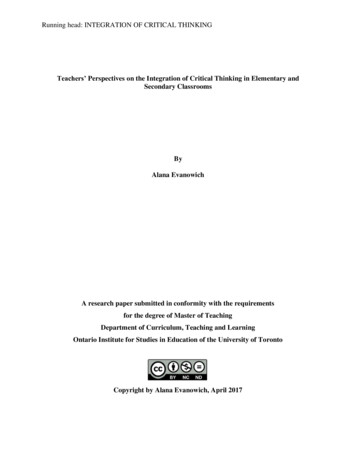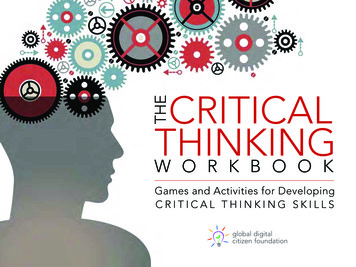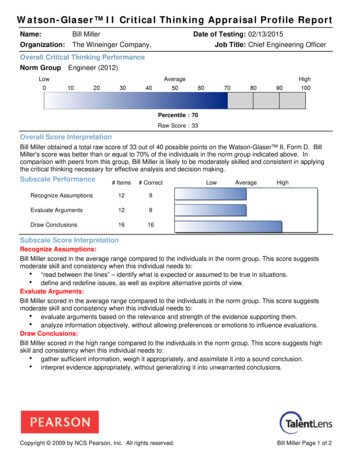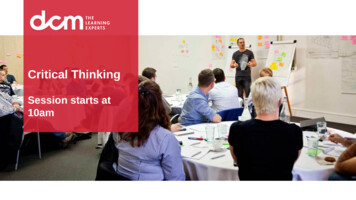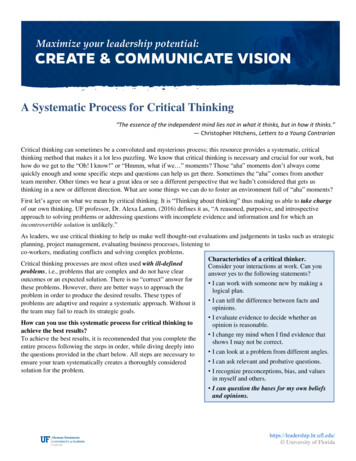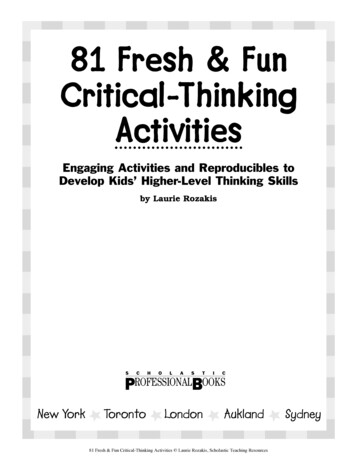
Transcription
81 Fresh & FunCritical-ThinkingActivitiesEngaging Activities and Reproducibles toDevelop Kids’ Higher-Level Thinking Skillsby Laurie RozakisSCHOLASTICPROFESSIONALBOOKSNew YorkTorontoLondonAukland81 Fresh & Fun Critical-Thinking Activities Laurie Rozakis, Scholastic Teaching ResourcesSydney
DedicationWith love and thanks, I dedicate this book to all the fine teachers who haveenriched my life: Barbara Bengels, Chris LaRosa, Ed Leigh, Jack McGrath,Jim Pepperman, Jennifer Richmond, Elizabeth Simmons, Lenore Strober,and Tom Thibadeau.Scholastic Inc. grants teachers permission to photocopy the activity sheets from this book for classroom use. No other part of this publication may be reproduced in whole or in part, or stored in aretrieval system, or transmitted in any form or by any means, without written permission of the publisher. For information regarding permission, write to Scholastic Professional Books, 555 Broadway,New York, NY 10012-3999.Cover design by Jaime LuceroInterior design by Jaime Lucero and Robert Dominguez for Grafica, Inc.Interior illustrations by Maxie ChamblissISBN: 0-590-37526-1Copyright 1998 by Laurie Rozakis. All rights reserved.Printed in the U.S.A.81 Fresh & Fun Critical-Thinking Activities Laurie Rozakis, Scholastic Teaching Resources
ContentsIntroduction . . . . . . . . . . . . . . . . . . . . . . . . . . . . . . . . . . . . . . 4Recognizing and Recalling Activities. . . . . . . . . . . . . . . . . . . . . . 6Distinguishing and Visualizing Activities . . . . . . . . . . . . . . . . . . . 20Activities for Following Directions and Classifying . . . . . . . . . . . 36Sequencing and Predicting Activities . . . . . . . . . . . . . . . . . . . . 50Activities for Inferring and Drawing Conclusions. . . . . . . . . . . . 64Evaluating Activities . . . . . . . . . . . . . . . . . . . . . . . . . . . . . . . . 74Analyzing Activities . . . . . . . . . . . . . . . . . . . . . . . . . . . . . . . . . 88Synthesizing Activities . . . . . . . . . . . . . . . . . . . . . . . . . . . . . . 102Answers . . . . . . . . . . . . . . . . . . . . . . . . . . . . . . . . . . . . . . . 11581 Fresh & Fun Critical-Thinking Activities Laurie Rozakis, Scholastic Teaching Resources
IntroductionToday’s students will inherit a complex and rapidly changing world, a world inwhich they’ll be required to absorb new ideas, examine and interpret information, apply knowledge, and solve unconventional problems. To deal with theinformation explosion of the twenty-first century, students will need to developsystematic ways of thinking and reasoning. Critical-thinking skills will be essential.What is critical thinking? It’s the ability to: solve problemsmake products that are valued in a particular culturebe flexible, creative, and originalthink about thinkinglocate the appropriate route to a goalcapture and transmit knowledgeexpress views and feelings appropriatelyEffective critical thinkers use one or more of the seven multiple intelligencesidentified by Dr. Howard hythmicinterpersonal (the ability to work cooperatively in a group)intrapersonal (self-identity)Research indicates that critical thinking is neither inborn nor naturallyacquired. In fact, fewer than half the adults in America today have the ability toreflect upon their thinking and explain how they solved a problem.Fortunately, critical thinking can be taught and learned. This book, and itscompanion volume for younger grades, will help you teach students to reflectupon their own thinking processes and become more successful, active learners. Both professional educators and parents can use this book to help childrenlearn to think critically.In our daily lives, we use many critical-thinking skills simultaneously—and notin any prescribed order. For the purposes of this book, however, the criticalthinking activities are arranged in a hierarchy, beginning with the skills of481 Fresh & Fun Critical-Thinking Activities Laurie Rozakis, Scholastic Teaching Resources
recognition and recall and working up to the more advanced skills of analysisand synthesis. This arrangement will help you and your students more clearlyunderstand and identify the specific critical-thinking skills they are using.For each thinking skill in this book, there are two kinds of activities: (1) thosethat you, as the teacher, will lead, and (2) student reproducibles for independent work. On the introductory pages for each section of the book, you’ll findideas for introducing and using the student reproducibles. You can use the TryThis! activity at the bottom of each reproducible as an extension of the lesson, achallenge activity, or a homework assignment.Here are some ways you can use the lessons to help students become moreeffective thinkers:1.2.3.4.5.6.7.8.9.10.Read each activity aloud or have a child read it aloudto the rest of the group.Allow children ample time to think and respond.Ask students questions to assess their understandingof the problem.Welcome different strategies for solving the problem.Encourage divergent thinking.Observe children as they work in order monitor theirproblem-solving skills.Give helpful hints to those children who are havingdifficulty finding ways to approach the problem.Guide children to link the problem to others theyhave already solved.Encourage children to check their work.Help children explore their thinking and identify thestrategies that worked—and those that didn’t.Invite students to share their results.Since critical thinking doesn’t end when an individual project does, you willwant to give students sufficient time to evaluate their thinking strategies. Guidestudents to formulate ways they might adjust their critical-thinking strategieswith the next problems they solve.Finally, model critical thinking for students by sharing your own problem-solving strategies and accepting unusual and unexpected strategies and solutions.Your participation as an active learner will further reinforce the critical-thinkingskills you teach.Above all, encourage your students to see themselves as thinkers.581 Fresh & Fun Critical-Thinking Activities Laurie Rozakis, Scholastic Teaching Resources
Recognizing and Recalling ActivitiesTo begin thinking critically, students must first learn to recognize and recall keyinformation. These skills are important for the mastery of higher-level skillssuch as classification, inferring, and analyzing.The activities in this section will help students tap their prior knowledge to identify and remember key facts. You can present each of the following activities as acomplete lesson or integrate the activities into lessons in different curriculumareas. The section begins with the easier activities and concludes with more difficult ones. Instructions for teacher-led activities appear on the same page as theactivity. Use the teacher notes that follow for the student reproducibles.Cross-Curricular LinksActivityTime CapsuleMind SqueezeTrivia TrackdownWordplayMaking a MenuRecycled WordsWhat Am I?Arctic FactsAntarctic FactsWhat’s Up & What’s ontent Arealanguage artslanguage artsmath, science/social studieslanguage artsscience/healthlanguage artslanguage arts/science/social studiesscience/social studiesscience/social studiesscience/social studiesmathematicsTeacher Notes for Student ReproduciblesPage 9: Mind SqueezeThis activity tests students’ observation and memory skills. After the class completes the reproducible, discuss various strategies that students used to recallthe items on the page. For example, they might have memorized them in rowsor columns; they might have classified them into groups.Page 10: Trivia TrackdownTrivia Trackdown is a great way to sharpen students’ recognition and recallingskills. You might begin by having students complete this page independently orwith a partner. Then have the class research general information on science,681 Fresh & Fun Critical-Thinking Activities Laurie Rozakis, Scholastic Teaching Resources
art, music, literature, sports, geography, history, and other subjects. Studentscan write questions on index cards with the answers on the back. Collect thecards and divide the class into teams. Have the teams line up on different sidesof the room and take turns answering the questions as you call them out.Award points for correctly answered questions.Page 11: WordplayBefore students begin this page, you might want to review the parts of speech—noun, pronouns and verbs—essential to a sentence. Invite students to readtheir word lists and paragraphs aloud to the class.Page 12: Making a MenuYou may wish to have students work with partners to complete this page.Encourage the teams to share their “menus” with the class.Page 13: Recycled WordsBefore assigning this page, review what students know about open and closedcompound words. Point out that compound words can also be proper nouns.Page 14: What Am I?After students complete the page, work with the class to come up with moredefinitions for other words beginning with h. Students might also enjoy actingout some of their definitions.Page 15: Arctic FactsThis page helps students recognize, recall, and organize facts. It also gives thempractice in extrapolating important information from a passage. Encourage students to paraphrase the information they include in the web.Page 16: Antarctic FactsThis page is similar to page 15. Completing the web will help students recognize, recall, and organize facts from a nonfiction passage. Discuss with the classwhy these are important skills.Pages 17–18: What’s Up and What’s Down?Students will need to review the information on pages 15 and 16 before playingthis game with a partner. Encourage the teams to make up additional questionsfor others to answer.Page 19: TransformationsThis page calls for students to use shape, size, and color to identify a pattern.You may wish to complete the first item with the class to be sure studentsunderstand what they are expected to do.781 Fresh & Fun Critical-Thinking Activities Laurie Rozakis, Scholastic Teaching Resources
Time CapsuleHere’s a unique way to use literature to help your students recognize and gather key ideas. Begin by selecting a novel or shortstory that the entire class has read fairly recently. Write the titleand the name of the main character on the chalkboard. Then askstudents to list six to ten items from the book that were important to the main character. This can be done individually or insmall groups. If the students read Gary Paulsen’s Hatchet, forexample, the list might look like this:hatchetbow and arrowairplanecavefirelakefishemergency transmitterraspberriesNext, ask students to put themselves in the main character’s place. As themain character, which of these items might they want to save in a time capsule? What other items might they add? Have each student create a shortlist of things they would put in a time capsule for the main character. Students should be able to explain their choices.You can expand this activity by having students make real time capsules forcharacters in other books and stories or for themselves. What items mightbest express other characters’ personalities—or their own? What items bestcapture the fictional or real experience? You might want to create a classtime capsule. Ask each student to contribute one item. Then bury the capsule somewhere on the school grounds.881 Fresh & Fun Critical-Thinking Activities Laurie Rozakis, Scholastic Teaching Resources
NameMind SqueezeTake two minutes to look at the words and objects on this page. Thenturn the page over and see how many you can recall. Good luck!HOMEWORKSTUDY!SUMMER VACATIONGOOD!RAINBOWSUNGLASSESLUNCHTr y T h i s !Do It AgainRepeat the activity. Can you improveyour performance?981 Fresh & Fun Critical-Thinking Activities Laurie Rozakis, Scholastic Teaching Resources
NameTrivia TrackdownHow many of these questions can you answer?1.How many squares are there on a checkerboard?2.What is the name of Mickey Mouse’s dog?3.What kind of animal is Babar?4.What was the name of the Wright Brothers’ airplane?5.What is the capital of New York?6.What do frogs have in their mouths that toads don’t?7.Who was the first woman to sit on the Supreme Court?8.What nations border the continental U.S. on the north and south?9.Who created The Cat in the Hat?10. How many queen bees are in each hive?11. Who was the second president of the United States?12. How many teaspoons make up a tablespoon?13. What two states share Kansas City?14. Who is the Friendly Ghost?15. Name the Great Lakes.16. Who painted the “Mona Lisa”?17. What substance inside corn makes it pop?18. How many sides are there on a snowflake?19. How many wings does a bee have?20. How many pints are in a quart?Tr y T h i s !10Think of AnotherThink of another triviaquestion for a classmate to answer.81 Fresh & Fun Critical-Thinking Activities Laurie Rozakis, Scholastic Teaching Resources
NameWordplayImagine you live in a world with only 20 words. You can use these20 words as much as you want, but you cannot use any other wordsat all. In the space below, list the 20 words you’d 10. 20.Tr y T h i s !Use Your WordsNow, write a paragraph usingonly your 20 words! Make sure your paragraphhas at least five sentences.1181 Fresh & Fun Critical-Thinking Activities Laurie Rozakis, Scholastic Teaching Resources
NameMaking a MenuIt’s dinner time, but what are you going to eat? Complete this pageto help you think of a menu.Food that begins with b :Food that grows below ground:1.1.2.2.3.3.4.4.5.5.Fast food:Food that grows on trees:1.1.2.2.3.3.4.4.5.5.Food that is white:Now, list your five favorite foods:1.1.2.2.3.3.4.4.5.5.Tr y T h i s !Favorite Foods Make a graph showing the fivefavorite foods of your classmates.1281 Fresh & Fun Critical-Thinking Activities Laurie Rozakis, Scholastic Teaching Resources
NameRecycled WordsYou probably recycle cans and newspapers, but did you know thatyou can recycle words too? You can use the same word to makemany different words and phrases. For example, you might use theword ice to make the words ice skate, iceberg or ice water.For each row, add the same word on the lines to make new words.Example:coat checkcoat roomcoat of r’s hellnogTr y T h i s !Use the WordsUse the words that youmade in sentences.1381 Fresh & Fun Critical-Thinking Activities Laurie Rozakis, Scholastic Teaching Resources
NameWhat Am I?Below is a list of definitions for words that begin with the letter h.See how many you can guess.Words That Start With h1.Balls of ice that fall from the sky2.A 17-syllable Japanese poem3.Not whole4.A patty of chopped beef5.An allergy to grasses and weeds6.The organ that pumps blood7.A great person; someone people admire8.Opposite of low9.The study of past events10. A country known for its tulipsTr y T h i s !Define ItWrite a definition for each of these h words:hello, handkerchief, horse.1481 Fresh & Fun Critical-Thinking Activities Laurie Rozakis, Scholastic Teaching Resources
NameArctic FactsRead the passage about the Arctic. Then fill in the web with factsfrom the passage. Include at least three facts for each heading.The Arctic is a large region of theearth around the North Pole. Thisregion includes the Arctic Ocean,Greenland, Iceland, thousands ofsmaller islands, and the northern partsof three continents: North America,Europe, and Asia. Many of the inhabitants are Eskimos, people native tothe region. Still others are Lapps,Yakuts, and Chukchi.Wildlife in the Arctic includeswolves, polar bears, foxes, many birds,caribou, lemmings, voles, walrus, andArctic hares. The most common Arcticfish is the char, a kind of trout.The Arctic climate is harsh. Temperatures can reach 70 degrees belowfreezing in the winter. Blustering windsmake the weather even more bitter.Summers are short and e1.2.3.1.2.3.Tr y T h i s !Add More Add another circle to the web. Label it“Plants”. Then find three facts to put in the circle.1581 Fresh & Fun Critical-Thinking Activities Laurie Rozakis, Scholastic Teaching Resources
NameAntarctic FactsRead the passage about the Antarctic. Then fill in the web with factsfrom the passage. Include at least three facts for each heading.Antarctica is the continent at theSouth Pole. Antarctica is surroundedby three oceans—the Atlantic, Pacific,and Indian. It is the fifth largest continent and the coldest place on Earth.Because it is below the equator, winterin Antarctica takes place when it issummer in the United States. Metalshatters like glass in the brutal Antarctic winter. Temperatures drop to 120below zero; a person without the rightclothing would freeze solid in just a fewminutes. Winds gusting up to 200 milesper hour come screaming down the ice,tearing into the piles of snow.With the exception of a few insects,Antarctica has no animal life on itsland. However, penguins, seals,whales, krill, and seabirds thrive in theoceans around the continent. Likewise,few plants besides mosses grow on theice-covered land of Antarctica.No people live permanently on thiscontinent, but Antarctica is known forits scientific stations. Many nations,including the U.S., Chile, Norway,Great Britain, and Australia have largeresearch centers where scientistsstudy earthquakes, gravity, oceans,and weather dlifeScience1.2.3.1.2.3.Tr y T h i s !16Learn More Find out about the firstpeople to explore Antarctica. Add anothercircle to the web to show what you learned.81 Fresh & Fun Critical-Thinking Activities Laurie Rozakis, Scholastic Teaching Resources
NameWhat’s Up and What’s Down?See how much you learned about the Arctic and Antarctic by playingthis game with a partner. Here’s how:1. Cut apart the cards, shuffle them, and place them in a stack facing down.2. Take turns picking a card and asking your partner a question.3. If their answer is correct, pick another card and ask another question. Ifthey answer incorrectly, they pick a card and ask you a question.4. The player who answers the most questions correctly wins.What continent is theSouth Pole on?What is the coldestplace on the earth?Who lives at the NorthPole today?{ { {[the South Pole,Antarctica][mostly Eskimos,Yakuts, Lapps, Chukchi]At which Pole can you findwolves, foxes, and polarbears?Who lives at the SouthPole today?[the North Pole][visiting scientists only][Antarctica]What large birds livenear Antartica?{ { {[penguins]Tr y T h i s !Find More Use a book to find moreanimals that you can add to this page.1781 Fresh & Fun Critical-Thinking Activities Laurie Rozakis, Scholastic Teaching Resources
NameWhat is a char?What kinds of plantsgrow at the South Pole?In what region of theearth would you findGreenland?{ { {[mostly mosses][a kind of trout][Arctic]What oceans surroundAntarctica?In which region would youexpect to find temperatures120 degrees below zero?Which region includesparts of other continents?{ { {[Antarctic][Arctic][Indian, Pacific, Atlantic]What do scientistsstudy on Antarctica?What animals live permanently on Antarctica’s land?What is the fifth largestcontinent?{ { {[Antarctica][none, only insects][earthquakes, weather conditions, gravity, oceans]Tr y T h i s !Write a Question Make up a question of your ownabout the Arctic or Antarctic. Have your partner answer it.1881 Fresh & Fun Critical-Thinking Activities Laurie Rozakis, Scholastic Teaching Resources
NameTransformationsStudy the first pair of shapes in each example. Think about how Achanges into B. Then look at C. Which of the six numbered shapeschanges in relation to C in the same way that A changes to B? Find thatshape. Circle the number of your 3456ABC1234562.3.4.5.6.Tr y T h i s !ExplainWrite a sentence or two to tell whyyou chose the answer you did.1981 Fresh & Fun Critical-Thinking Activities Laurie Rozakis, Scholastic Teaching Resources
Distinguishing and Visualizing ActivitiesWhen students become skilled at distinguishing between important and unimportant data and visualizing problem-solving strategies, they naturally developmore logical and effective patterns of thinking. The activities in this section willhelp students learn to identify specific items and form strong mental images.Use the chart to help you relate the activities in this section to your class curriculum. In general, the easier activities appear at the beginning of the section,and the more difficult ones follow. Instructions for teacher-led activities are onthe same page as the activity. Notes for using the student reproducibles followthe chart.Cross-Curricular LinksActivitySet the SceneThe QqqqqoooooTight FitWithin a WordReal EstatePage2223242526Tricky TwinsStargazingTriangle ChallengeTangrams27282930How Do You Hide an Elephant?Magic WordsAnagram AdventureOrigami31323334–35Content Areaart/language artsart/language artsart/mathematicslanguage artssocial csmath/multicultural/artlanguage artslanguage artslanguage artsmulticultural/artTeacher Notes for Student ReproduciblesPage 23: The QqqqqoooooAs a follow-up to this activity, you might have students write a story about thecreature they create. Invite students to share their artwork and stories with theclass.2081 Fresh & Fun Critical-Thinking Activities Laurie Rozakis, Scholastic Teaching Resources
Page 25: Within a WordIn this activity, students must visualize the word bar in other, longer words.Follow up by having students write a sentence using each of the words theyidentify.Page 26: Real EstateBefore students complete this page, you might want to discuss the term realestate to make sure everyone knows what it means. Follow up by talking aboutthe variety of homes pictured and how and why homes differ around the world.Page 27: Tricky TwinsTo further enhance students’ visual skills, have them describe each pair of catsthat they identify.Page 28: StargazingFollow up by having students find at least one fact about each of the names onthe puzzle.Page 29: Triangle ChallengeBefore students begin working on the page, have them identify the kind of triangle they see (equilateral). What other kinds of triangles can students name?What other geometrical shapes?Page 30: TangramsHave students identify the geometrical shapes that make up the seven tangrampieces. Create a bulletin board display with the tangram pictures studentsmake.Page 31: How Do You Hide an Elephant?Point out to students that they can use the hidden word idea as a code. Challenge them to write coded messages.Page 32: Magic WordsIn this activity, students must visualize and rearrange letters into different wordconfigurations. Challenge students to use the new words in complete sentences.Page 33: Anagram AdventureThis page builds on the activity on page 32. However, students are now asked torearrange letters to create more than one word. Again, encourage students touse the words they create in complete sentences.2181 Fresh & Fun Critical-Thinking Activities Laurie Rozakis, Scholastic Teaching Resources
Set the SceneOne way to enhance student’s visualization skills is to have themcreate dioramas or other three-dimensional representations of specific scenes from literature. Ask students to bring in shoe boxes.Begin the activity by reviewing the stories, poems, novels, and playsthe class has read during the year. Discuss scenes that are especially dramatic. List some of these scenes on the chalkboard.Then invite students to select a scene to bring to life. They may want to sketchthe scene on a piece of paper before transforming it into three-dimensionalform. Students can use construction paper and small objects such as pebbles,sticks, and blocks in their scenes. Encourage them to experiment with depthand space by placing figures and objects in the background, middle ground,and foreground of their scenes. Students can use strips of fanned paper toanchor the figures and objects.2281 Fresh & Fun Critical-Thinking Activities Laurie Rozakis, Scholastic Teaching Resources
NameThe QqqqqoooooWhat’s a Qqqqqooooo? It’s a make-believecreature made from letters. Make a lettercreature of your own. It can be a real animalor a make-believe one.Here’s what you’ll need:old newspapers or magazinespen or pencilgluescissorsconstruction paperHere’s what to do:1. Pick any two letters.2. Cut a pile of these letters from old newspapers or magazines.3. Put the letters together to make a creature. When you like the way theylook, glue the letters down in the frame on this page.Tr y T h i s !Introduce Your Creature Give your creature a nameand write a brief description of it, including where it lives,what it eats, and what makes it special.2381 Fresh & Fun Critical-Thinking Activities Laurie Rozakis, Scholastic Teaching Resources
Tight FitThis activity is an interesting way for students to practice distinguishing and visualizing both positive and negative space.Materials:construction paperscissorscrayonsDirections:1. Arrange students in small groups of four or five. Give each group a stack ofpaper, some crayons, and a pair of scissors per student.2. Have each student fold one sheet of paper in half and draw a geometricdesign along the folded edge. Caution students not to copy each other’sdrawings.3. Then have students cut out their shapes along the fold so that they havetwo pieces of paper—the shape and the leftover paper.4. Have each group select a member to collect all the cut-out shapes. Thisperson becomes the first player.5. The rest of the group makes a circle around the player anddisplays one of the cut papers, unfolded.6. The player must try to visualize which “negative” each cut-out “positive” fitsand then place the shape in the open space.7. When the player has correctly fit each shape to its template, have eachgroup select a new player and repeat the round.8. After two or three rounds, invite groups to exchange their cut-outs andnegatives and continue playing.2481 Fresh & Fun Critical-Thinking Activities Laurie Rozakis, Scholastic Teaching Resources
NameWithin a WordCan you find the word bar in the word for each of these pictures?Write the word on the line.1.2.3.4.5.6.7.8.9.Tr y T h i s !Find More Think of at least three morewords with bar in them.2581 Fresh & Fun Critical-Thinking Activities Laurie Rozakis, Scholastic Teaching Resources
NameReal EstateLook carefully at the homes on this page. Then answer the questions.1. How many homes have onlytwo windows and one door?2. How many homes have nowindows?3. How many homes are not forpeople?4. How many homes do not have5. How many homes float?6. How many homes have flagsflying?7. How many homes have 12 ormore windows?8. How many homes have a porch?walls made of wood?Tr y T h i s !26Draw Draw a picture ofanother home. Then rereadthe questions. How do the answers change?81 Fresh & Fun Critical-Thinking Activities Laurie Rozakis, Scholastic Teaching Resources
NameTricky TwinsThe cats are having a party. Most of the cats are twins dressed justalike and standing the same way, but three single cats are at theparty, too. With a colored pen or pencil, find and number the 12pairs of identical twins. Then circle the three cats that have no twin.Tr y T h i s !Draw Choose one of the single cats. Draw atwin for that cat.2781 Fresh & Fun Critical-Thinking Activities Laurie Rozakis, Scholastic Teaching Resources
NameStargazingIt’s time to study the skies, but you won’t need a telescope! Why?Because some stellar things are hidden in this puzzle. Find each ofthe heavenly bodies listed below. The words go across, down, andbackwards.Find these words:OrionSunSaturnMilky WayTr y T h i s !28EarthMarsNorth StarVenusClassifyMoonPlutoLook at the names you found. Thinkof a way to classify them into groups.81 Fresh & Fun Critical-Thinking Activities Laurie Rozakis, Scholastic Teaching Resources
NameTriangle ChallengeHow many triangles can you find in this shape? Use colored pencilsto outline each triangle. Write your total in the space below.There are triangles.Tr y T h i s !Look AgainRemove one line from the shape. Nowhow many triangles are there?2981 Fresh & Fun Critical-Thinking Activities Laurie Rozakis, Scholastic Teaching Resources
NameTangramsA tangram is a Chinese puzzle made from a square cut into sevenpieces—5 triangles, 1 square, and 1 rhomboid. You can use tangrampieces to make different figures. Here’s how:1.Cut out the square.2.Cut on the lines to make the five triangles, one square, and one rhomboid.3.Arrange the shapes to make the figure on this page.4.Now make your own tangram pictures. Glue the pieces in place for thepicture you like the best.Tr y T h i s !Make MoreUse all seven tangram pieces tomake a vehicle.3081 Fresh & Fun Critical-Thinking Activities Laurie Rozakis, Scholastic Teaching Resources
NameHow Do You Hide an Elephant?You probably can’t hide an elephant in your room, butyou can hide one in a sentence. Let’s start small. Canyou find the goat that is hiding in the sentence below?Lisa will go at dinner time.The two words go at spell goat when you put themtogether.Now, find these animals in the sentences below. Underline the letters that spell the animal ce1. Go fish or see what we have to eat in the refrigerator.2. Be artistic and paint a picture for me.3. She needs a new cover for her book.4. Tom iced the cake for the birthday party.5. Do girls like soccer or baseball?6. Ms. Dee read a book to the class.7. What a big bowl
understand and identify the specific critical-thinking skills they are using. For each thinking skill in this book, there are two kinds of activities: (1) those that you, as the teacher, will lead, and (2) student reproducibles for indepen-dent work. On the int



